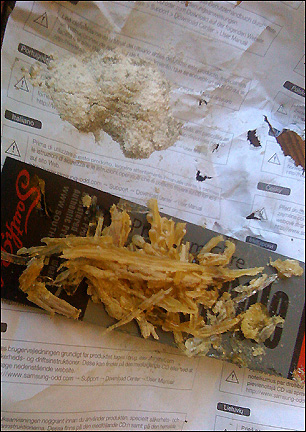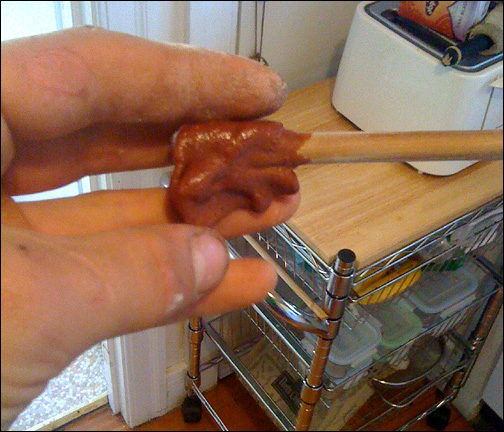
Pine pitch and hardener.
I ended up needing 3x as much hardener.
I have read a couple of formulas for hardening pine pitch or other conifer pitch. One calls for a 5:1 pitch to hardener ratio, the hardener being wood ash. For starters, wood ash is the least reliable hardener. There are many other suitable hardeners. The main thing I find is make sure they are ground to a VERY FINE powder. Here, I've used powered stone dust. I've used soapstone, pipestone and some soft bluish stone from my front yard. The softer the stone, the easier it is to file the stone to make some hardener.

Pine pitch and hardener.
I ended up needing 3x as much hardener.
First, I put the pitch in a can. Primitively, I would use a shell heated on a hot rock. Then, when the pitch is fully liquefied, I add the hardener bit by bit while stirring it in completely before adding more. When it’s done, the pitch solution will be a lot thicker and will not bubble anymore. It will also harden rapidly when a glob is scooped out on a stick. The pitch solution will not be as runny. Care must be taken because the hotter the pitch gets, the more brittle it will become. If it spills onto the broiler, the pitch will catch on fire. It will be worse than an oil fire.

In this picture, I scooped out some pitch onto my pitch stick. About ten seconds later, it was touchable.
The red color is from a previous batch hardened with powdered pipestone that was remnants in the can.

The resulting “pitch stick”.
If done correctly, it is basically unaffected by body heat. It is a serious epoxy when used with a liberal coating. The pitch is incredibly strong. I have yet to do this, but I have been told the addition of beeswax to the liquid pitch will add a flex. Tallow may do the same.

The hafting of a stone knife.
A scrub oak handle wrapped in buffalo leather.
The epoxy fully covered the slot in the wood and the knife tang. The pitched area was then wrapped in raffia cordage for additional strength. The cordage melted into the pitch at the bottom. I cut some leather and soaked it until it was fully saturated and stretchy. I sewed it on wet so it would stretch to fit. The leather covered the bottom “loose” end of the cordage even though the cordage was glued on. When it dried, the leather shrank and clamped down over the glued spot on the cordage wrap,
![]()
E-mail your comments to "Cezanne Deraymond" at boondockz@gmail.com
We hope the information on the PrimitiveWays website is both instructional and enjoyable. Understand that no warranty or guarantee is included. We expect adults to act responsibly and children to be supervised by a responsible adult. If you use the information on this site to create your own projects or if you try techniques described on PrimitiveWays, behave in accordance with applicable laws, and think about the sustainability of natural resources. Using tools or techniques described on PrimitiveWays can be dangerous with exposure to heavy, sharp or pointed objects, fire, stone tools and hazards present in outdoor settings. Without proper care and caution, or if done incorrectly, there is a risk of property damage, personal injury or even death. So, be advised: Anyone using any information provided on the PrimitiveWays website assumes responsibility for using proper care and caution to protect property, the life, health and safety of himself or herself and all others. He or she expressly assumes all risk of harm or damage to all persons or property proximately caused by the use of this information.
© PrimitiveWays 2013